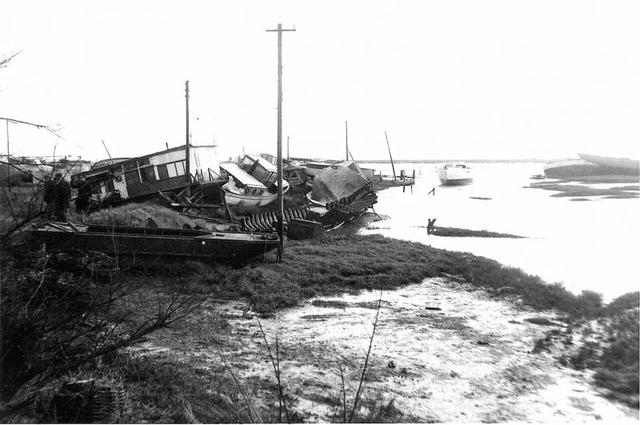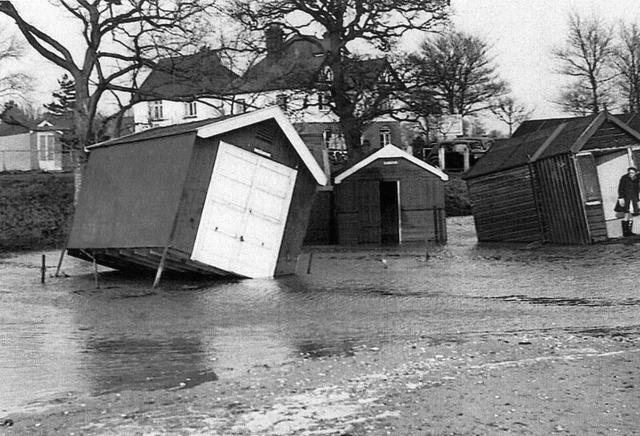This year marks the 70th anniversary of one of the worst floods in England and Scotland during the 20th Century. It was one of Britain's most significant peacetime tragedies, with Winston Churchill calling it a "shocking and tragic disaster". Essex was heavily affected, with many lives lost and thousands of homes destroyed.
A major rescue operation was mounted to evacuate as many people from the flooded areas as possible, with around 10,000 people evacuated from Canvey Island alone.
Canvey was one of the communities in Essex that suffered the most significant loss of life, with 58 deaths. In Jaywick, 35 people died, and there were 120 total deaths recorded in Essex.
In the following video, Ray Howard MBE and Malcolm MacGregor recall the floods in Canvey Island:
Cllr John Jowers, Deputy Mayor of Colchester, was a young boy living on Mersea Island at the time. He reflects:
"As a young boy, I recall the events of that night living on Mersea Island, but it is for many others a particularly poignant realisation that there was almost a total lack of warnings which could have saved lives. So, while the first impact was felt in Lincolnshire, the people of Essex were unaware of the events unfolding and were still enjoying an ordinary Saturday evening.
As we approach the anniversary, when even fewer of those with first-hand memories are still with us, it is appropriate to remember, reflect and focus on what we can do to support our communities, whatever our roles might be.
We have significantly improved our flood defenses in Essex, but we can never be complacent, and we hope that none of our communities ever have to face the tragic events of January 1953 again."

Wrecked houseboats on Mersea Island after the 1953 flood. Photograph taken by Brian Jay and provided courtesy of Mersea Island Museum
Cllr Peter Schwier, Essex County Council Climate Czar, says:
"The 1953 floods of the Essex coast tragically remind us of the importance of collaborative work by local government and agencies. It is important to ensure that well-designed, sustainable measures that address flooding, also combine environmental mitigation measures. These benefit residents and the natural flora and fauna and afford greater protection and resilience for our coastal communities."

Damaged beach huts on Mersea Island after the 1953 flood. Photograph taken by Brian Jay and provided courtesy of Mersea Island Museum
In the aftermath of the 1953 floods, a major sea defense construction programme began, which included sea walls at Canvey Island and Jaywick. The investment into these flood defenses, plus the addition of flood warning systems, meant that flooding was much less extensive and, most importantly, there was no loss of life during a similar scale flood event in 2007.
The flood warning system is operated by the Environment Agency, which uses information from the Met Office and other sources. Live flood warnings and maps are published on the UK Government website, and you can receive direct flood warnings by telephone, text message and email if you sign up here.
In addition to using hard defenses such as sea walls, the flood and water management team at Essex is continuously incorporating nature-based solutions to prevent flooding. Nature-based solutions prevent flooding in a sustainable way while offering a whole host of other social and environmental benefits, including improving water quality and recharging groundwater supplies. Examples include but are not limited to detention basins which can double as playing fields, and leaky dams, which slow the flow of water upstream and promote wetlands and bringing back flood plains. See Leaky dams in action at Thorndon, Weald and Parndon woods. Visit Essex Flood and Water Management to find out more about what we do to help communities stay safe from flooding.
The following events are taking place to commemorate the tragedy:
Select dates from Saturday, 28 January to Thursday, 23 February
- Jaywick Martello Tower - Tides of Tendring exhibiting exploring the events of the 1953 floods
Tuesday, 31 January
- Harwich Museum - 1953 Flood Talk by David Whittle at 11 am
Wednesday, 1 February
- Canvey Island Library - Exhibition of Photography from Canvey Community Archive (CCA) and the Essex Record Office, from 10 am
- Canvey Island Library - The HM Lord Lieutenant of Essex will unveil a blue commemoration plaque at 2 pm
- Harwich Flood Memorial Garden - Rededication of the Flood Memorial Garden
Thursday, 2 February
- Canvey Island Library - Exhibition of Photography from Canvey Community Archive (CCA) and the Essex Record Office, from 10 am
Saturday, 25 February
St Nicholas Church, Canvey Island - A commemorative exhibition of newspaper reports and photography from 1953.







